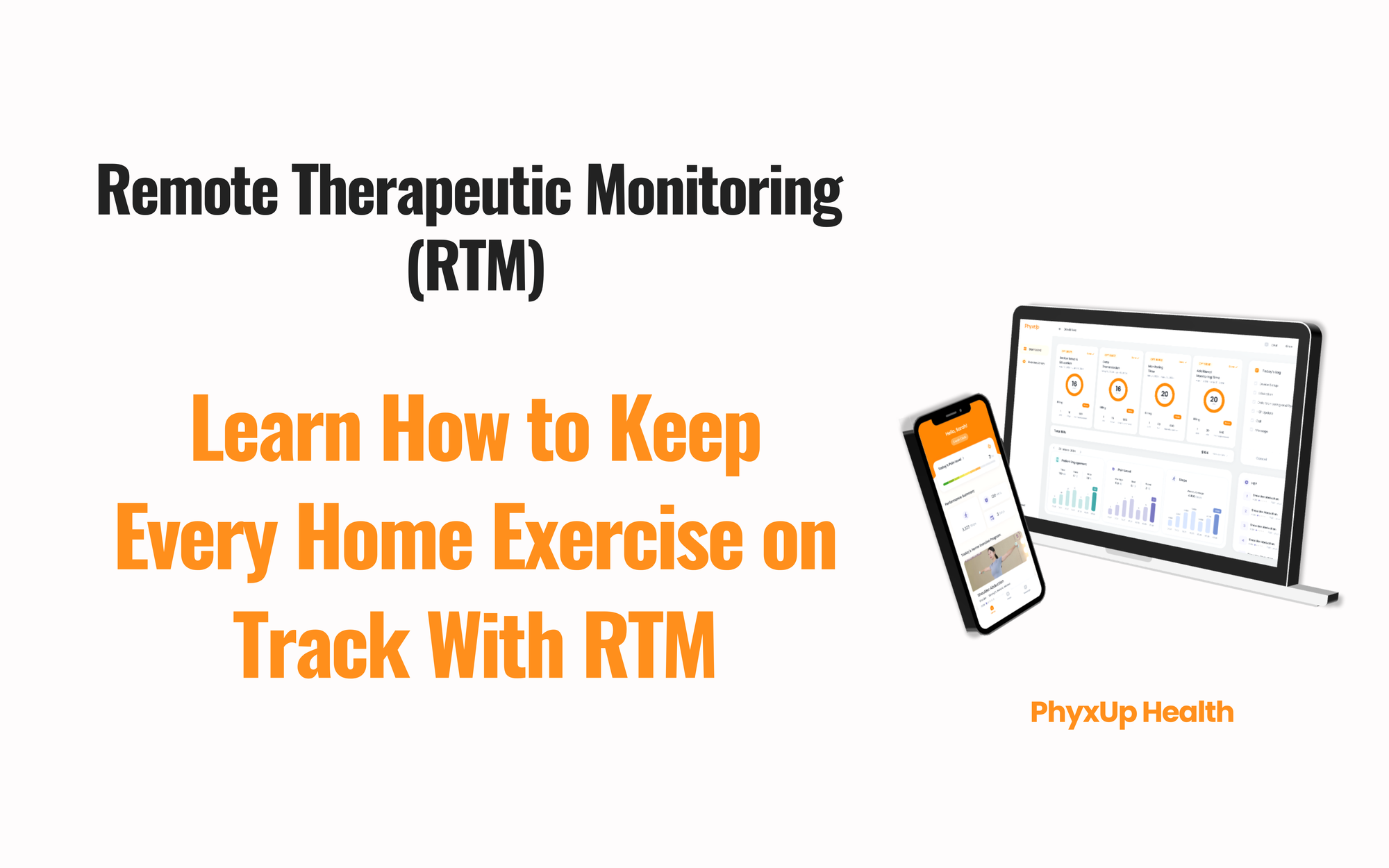Why Patients Skip Home Exercises—And How Remote Therapeutic Monitoring Fixes It

Ask any physical therapist what slows recovery, and you’ll hear the same story: patients stop doing their at-home exercises. The stretches feel repetitive, life gets busy, discomfort creeps in, and the printed handout lands in a drawer.
Remote Therapeutic Monitoring (RTM) keeps therapists and patients connected between visits, tracks Home Exercise Program (HEP) progress and adherence in real time, and lets clinics bill for the time they already devote to guiding care.
RTM is a simple app that delivers HEP videos to patients, tracks their progress and adherence in real time, alerts therapists to issues, and records everything so clinics can bill for the monitoring time.
Below is a fresh look at why HEP adherence matters, what commonly derails it, and how RTM turns those hurdles into stepping-stones for better outcomes and healthier clinic revenue. We’ll walk through the research, the tech, and some field-tested tips you can apply right away.
Why the “Between-Visit Gap” Matters So Much
A single session in the clinic can only do so much. Muscles rebuild and joints regain control during the other 23 hours of the day. When patients follow their HEP consistently, studies show:
- 25–35 % greater gains in strength and mobility within 6–12 weeks (British Journal of Sports Medicine).
- Up to 40 % faster return to full function (Journal of Orthopaedic & Sports Physical Therapy).
- Lower reinjury rates and fewer unplanned visits, which keeps overall healthcare costs down.
Yet adherence still hovers around 30–50 % (Physical Therapy & Rehabilitation Journal). The gap between “ideal” and “real” is wide and expensive.
Three Classic Roadblocks (and How RTM Clears Them)
- Accountability fades
Patient says: “I meant to do the exercises…but no one checked.”
✅ RTM fix: The app sends automatic reminders, tracks daily streaks, and lets patients log pain with just two taps. Therapists see the updates right away, follow up quickly, and patients stay on track.
- Discomfort or fatigue
Patient says: “It hurt, so I stopped.”
✅ RTM fix: Patients log pain scores; the therapist sees them the same day, tweaks reps or range, and offers reassurance—before one bad rep turns into a week of avoidance.
- Monotony
Patient says: “It’s boring—I can’t tell if I’m improving.”
✅ RTM fix: The platform shows simple charts of pain levels and movement gains, celebrates streaks, and updates exercises automatically, turning invisible progress into visible wins that keep patients engaged.
Five Simple Ways to Boost HEP Success with RTM
- Put the program in their pocket.
Use your RTM app to push short, step-by-step HEP videos straight to each patient’s phone. No printed handouts, no guessing. - Watch the numbers, not your watch.
The app automatically records reps, pain scores, and steps data, giving you a live dashboard of who’s on track and who needs help—zero extra paperwork. - Tweak the plan in real time.
See a plateau? One tap swaps out an exercise or adjusts the intensity, so the HEP always matches the patient’s current ability. - Show you’re watching—patients work harder.
When patients know their therapist is reviewing every log, they stick to the program and push for streaks. Personal messages or quick emojis keep the momentum high. - Turn guidance into revenue.
Log the minutes spent reviewing data and updating plans, then bill those minutes under the RTM CPT codes. RTM lets you capture the value of the care you’re already providing between visits.
How RTM Makes Clinical and Financial Sense
Remote Therapeutic Monitoring isn’t just fancy accountability software; it’s built into modern reimbursement codes (CPT 98975, 98977, 98980, 98981). In practical terms:
- Billable time: You can capture the minutes spent reviewing data, adjusting the HEP, and messaging the client. Those tasks already happen informally—now they generate revenue.
- No extra staff required: A well-designed platform streamlines data review with color-coded alerts; therapists spend minutes, not hours, triaging.
- Better outcomes = stronger referrals: Satisfied patients share their faster progress with physicians and friends, feeding the top of your funnel at zero marketing cost.
A Simple Roll-Out Plan for RTM
- Week 1 – Start Small
- Pick one tech-savvy therapist.
- Add five patients who need extra follow-through.
- Upload their HEP videos and teach them to log pain/reps (≈10 min each).
- Weeks 2–3 – Find Your Rhythm
- Therapist glances at the RTM dashboard once a day, sends a short note, and records the time for billing.
- Watch two simple numbers: daily logs and pain-score trends. Send a reminder if someone skips three days.
- Weeks 4–6 – Add Gradually
- Invite five more patients and one more therapist.
- Hold a 15-minute huddle to swap tips (best reminder times, quick-reply templates).
- Clarify who checks alerts and who logs billing.
- Month 2+ – Standardize & Scale
- Make RTM onboarding part of every new-patient intake.
- Share a one-page “3-step daily RTM review” so any therapist can cover for another.
- Aim for 10–15 RTM patients per therapist before expanding again.
- Every Month – Measure & Tweak
- Pull one report: adherence rate, average pain change, and RTM revenue.
- Adjust reminders, video length, or staffing based on what the numbers say.
Stories from the Field
“Before RTM, only about 40 % of my post-op knees finished the full HEP. Now we’re above 75 %, and they’re hitting flexion goals a week sooner.”
—Dr. Maya Nguyen, PT, DPT
“I used to phone patients on lunch breaks just to keep them on track. The platform automates half those touches, so I focus on tweaking the plan—not chasing people.”
—Alex Martinez, PT clinic owner, Chicago
These anecdotes mirror early data: higher adherence, shorter episode lengths, and happier clinicians.
Looking Ahead: RTM as Standard of Care
Telehealth proved that remote visits are feasible. RTM goes further, weaving therapy into daily life and turning data into action. As value-based care models expand, insurers will increasingly reward measurable engagement and outcomes, precisely what RTM captures.
Forward-thinking clinics that adopt RTM now won’t just keep pace; they’ll set the bar for patient-centered, data-driven rehabilitation.
Ready to See It in Action?
Whether you’re a solo practitioner or manage multiple locations, adding RTM can be surprisingly seamless. Platforms like PhyxUp Health handle the heavy lifting—setup takes minutes, and ongoing reviews fit naturally into existing workflows.
Curious how it might look in your day-to-day? Explore a live demo, browse case studies, or dive deeper into reimbursement details at phyxuphealth.com.
Turn that between-visit gap into your clinic’s biggest advantage—one engaged patient at a time.
